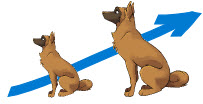Numbers
Directed
Numbers
Many
of the numbers we use represent situations which have directions as well as size
The numbers which have a direction and a size are called directed numbers.
Once a direction is chosen as positive (+), the opposite direction is taken as negative (- ).
For example:
If above zero degrees is positive (+), then below zero degrees is negative.
If north is positive (+), then south is negative (-).
If profit is positive (+), then loss is negative (-).
Directed numbers are used in Mathematics, Engineering, Business and the Sciences.
For example: -15, 8, 100, -100, -3.5, 0.33, -0.75 are directed numbers.
In the above example -15, 8, 100, -100 are called integers.
When writing positive numbers you can leave the positive sign and just write the number.
eg. +8 as 8
If a directed number is a whole number, it is called an integer.
The numbers which have a direction and a size are called directed numbers.
Once a direction is chosen as positive (+), the opposite direction is taken as negative (- ).
For example:
If above zero degrees is positive (+), then below zero degrees is negative.
If north is positive (+), then south is negative (-).
If profit is positive (+), then loss is negative (-).
Directed numbers are used in Mathematics, Engineering, Business and the Sciences.
For example: -15, 8, 100, -100, -3.5, 0.33, -0.75 are directed numbers.
In the above example -15, 8, 100, -100 are called integers.
When writing positive numbers you can leave the positive sign and just write the number.
eg. +8 as 8
If a directed number is a whole number, it is called an integer.
Example
Addition of Directed Numbers
Let's consider -3 + + 4
In this problem + and + signs are side by side.There is no number in between them. So the two positive signs which are side by side gives a positive sign.
Remember this,
Two like signs give a positive sign
+ + = +
-3 + + 4 = - 3 + 4
= 1
Sometimes directed numbers are written as








